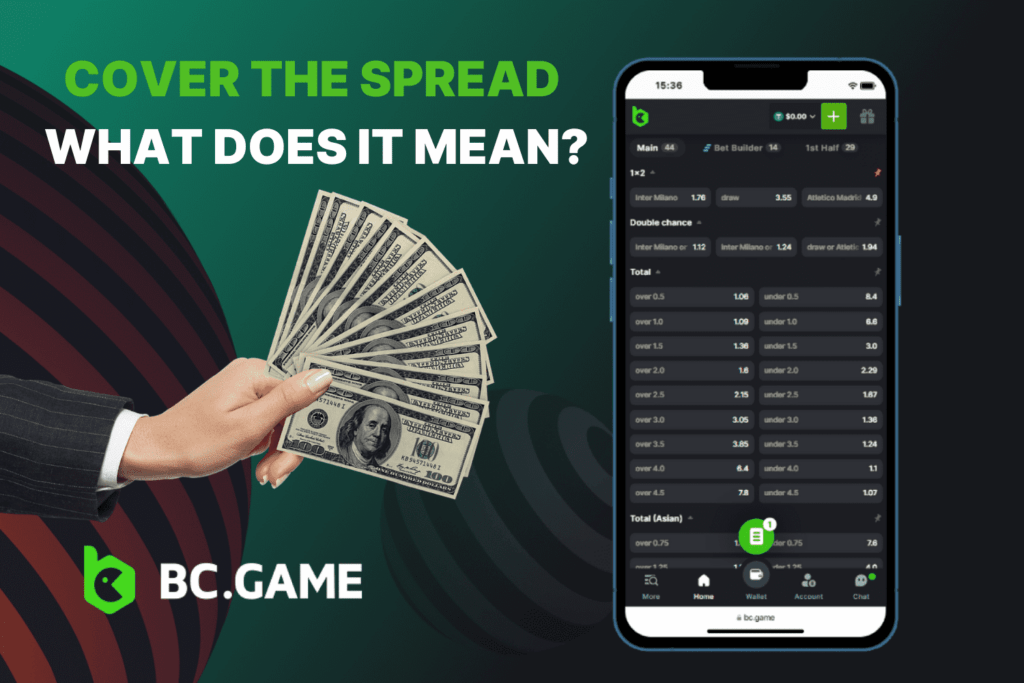
Understanding basic terms is critical for everyone participating in sports betting. This article goes into “covering the spread,” a popular betting technique that tries to equalize the odds between teams of differing strengths, by defining the term, explaining how oddsmakers generate these spreads, and discussing effective betting tactics. We’ll find out what does cover the spread mean.
What Does “Cover the Spread” Mean?
The concept of “covering the spread,” which may be strange to beginners, is fundamental to sports betting. Essentially, it involves a team surpassing the expectations set by the betting market. Almost every contest features an underdog and a favorite. The favorite is anticipated to win, but to make betting more intriguing and equitable, bookmakers use a point spread—a handicap that the favorite must surpass in order to win a wager. This strategy ensures that a wager on the favorite must win by a larger margin than the spread, whilst betting on the underdog requires them to win outright or lose by less than the spread.
How Does “Covering the Spread” Work?
“Covering the spread” merges the unpredictability of sports with the strategic calculations of bettors, embodying the core concept of spread betting. This process starts with sportsbooks, or bookies, who are crucial in establishing the odds for sports events. They set the point spread to even out the competition between teams of differing strengths. This setup requires betting on the favorite to not only win but to win by a specified margin, thus integrating the cover the spread meaning into the betting strategy. This dimension of betting injects an additional layer of complexity and strategy, encouraging bettors to undertake in-depth analysis. Understanding the determination of these spreads and their significance allows bettors to refine their strategies, leveraging the point spread to improve their chances of success.
What’s an Example of Cover the Spread?
Consider the excitement around a Champions League final, where FC Barcelona and Manchester United will compete on football’s biggest platform. The excitement among fans and bettors alike grows as bookmakers methodically set the stage with their odds for this highly anticipated matchup.
With FC Barcelona having had a successful league season and Manchester United mounting a spectacular comeback to clinch their berth in the final, bookies have Barcelona as the favorites, with a 1.5-goal spread. To “cover the spread,” Barcelona must win by at least two goals.
Consider a scenario where a bettor places their confidence in Barcelona’s superior form and attacking prowess to beat the spread. This bet hinges on Barcelona securing a victory by at least two goals. Conversely, a wager on Manchester United under this premise would necessitate United winning the match, drawing, or losing by just a single goal for the bet to be successful.
Imagine the match concludes with Barcelona clinching a 3-1 victory. This result signifies Barcelona has covered the spread, ensuring a win for bettors who predicted a victory margin of two goals or more. On the other hand, bets on Manchester United would not come to fruition in this scenario. Yet, had Barcelona won by exactly one goal, it would have perfectly matched the spread set by oddsmakers, resulting in a “push” with all bets refunded, as the match outcome precisely met the expectations. This scenario highlights the strategic nuances and the importance of understanding cover odds in spread betting, which adds an intricate layer to wagering in European football.
Understanding Spread Betting vs. Moneyline and Totals Betting
What does it mean to cover the spread? Navigating the world of sports betting can be both thrilling and confusing, with numerous sorts of wagers providing different opportunities to interact with and predict the outcomes of sporting events. Point spread betting is one of the most popular strategies among bettors, but it is only one of several options. Understanding the differences between spread betting, moneyline betting, and totals betting is essential for anyone trying to get into sports betting.
The Essentials of Moneyline Betting
At its core, moneyline betting strips the process down to its most straightforward form: betting on which team will emerge victorious in a game, without any point spreads involved. This form of betting assigns odds to both the favorite and the underdog. These odds determine the payout for a winning bet. For instance, let’s say a bettor believes in an underdog victory in the Super Bowl, choosing the Broncos over the Seahawks. If the Broncos clinch the win, the bettor secures their payout, which is typically higher when betting on the underdog due to the risk involved. Conversely, a loss for the Broncos means the bettor loses their stake. Moneyline bets offer a simple, direct way to back a team’s outright win, but they often present less favorable odds for betting on favorites, making the risk-reward calculation a key part of the betting strategy.
The Basics of Totals Betting
Also known in the betting community as an over/under bet, totals betting focuses on the cumulative score of both teams in a game. Rather than picking a winner, bettors wager on whether the total points scored will be over or under a specific number set by the sportsbooks. For example, if a sportsbook sets the over/under for the Super Bowl at 55 points, bettors can place wagers on the actual combined score being either higher or lower than this threshold. This type of bet allows for a different strategic approach, as it requires consideration of both teams’ offensive and defensive capabilities, recent performance trends, and any external factors that could influence the total score, such as weather conditions or injuries.
Deciphering the Point Spread
The concept of the point spread is a cornerstone of sports betting, crafted to equalize the playing field and encourage betting on both competing teams. By assigning a numerical value to the expected difference in scores, oddsmakers aim to spark interest across the board, ensuring that every game presents a worthwhile betting opportunity regardless of the teams’ perceived disparities.
Interpreting a 3 Point Spread
A 3 point spread is indicative of a closely matched competition, where the favored team is expected to win by a narrow margin. This small spread suggests that the game is anticipated to be competitive, with a real possibility for either team to emerge victorious. In scenarios where a team is favored by three points, betting on the underdog could be particularly appealing if you believe the game will be decided by a field goal or less, a common occurrence in football.
Explaining the 2.5 Point Spread
The introduction of a +2.5 point spread sets the stage for a closely contested battle, where the underdog is given a slight cushion. Should the underdog team lose by no more than two points, or win outright, they “cover the spread,” making bets on them successful. This margin is especially significant in sports like football and basketball, where the dynamics of the game can lead to narrow victories. For instance, if the Milwaukee Bucks are set at +2.5 against the Golden State Warriors, a bet on the Bucks means you’re predicting a tight game, possibly decided in the final moments. Such a spread suggests that the match is expected to be so closely contested that a mere basket or a last-second play could tilt the outcome.
Understanding a 1.5 Point Spread
A 1.5 point spread signals an even tighter contest, often too close to call, where any slight advantage could be decisive. This minimal spread points towards a belief by oddsmakers that the game could realistically go either way. Given the rarity of one-point margins in football and basketball, bettors might lean towards the moneyline when the spread is this narrow, seeking potentially more favorable odds without the risk of losing their bet by a slim margin.

Grasping a 0 Point Spread
The occurrence of a 0 point spread, or a “pick’em,” is where oddsmakers see the teams as perfectly matched, with no clear favorite. This scenario is less common but presents an interesting betting opportunity, as the winner of the game is the winner of the bet, pure and simple. The introduction of a half-point, or “hook,” eliminates the possibility of a push, ensuring that every bet has a definitive outcome. This nuance in spread betting underscores the importance of understanding the implications of these numbers, as they can significantly influence betting strategies and outcomes.
“Cover the Spread” By Sport
What is covering the spread in sport betting? The term “cover the spread” is a staple in sports betting vernacular, transcending across different sports with its universally applied principle. Understanding how this concept applies to various sports is key to making informed betting decisions. Each sport has its unique dynamics and scoring systems, influencing how spreads are set and interpreted. Let’s delve into how covering the spread plays out in football, basketball, and baseball, complete with examples to illuminate the process.
Football (+Example)
In football, the point spread is a critical element used to balance out the betting field, especially given the sport’s potential for varied margins of victory. For instance, consider a matchup between the New England Patriots and the Miami Dolphins, where the Patriots are favored by 7 points (-7). If you bet on the Patriots to beat the spread, they must win by more than 7 points. Should the Patriots win 28-20, they cover the spread, and your bet is a win. However, if they win 24-20, they do not cover the spread, resulting in a loss for bets placed on them.
Basketball (+Example)
Basketball’s high-scoring nature and rapid score changes make spread betting particularly interesting. Let’s say the Los Angeles Lakers are playing the Chicago Bulls, with the Lakers as 5.5-point favorites (-5.5). To cover the spread, the Lakers need to win by at least 6 points. A final score of Lakers 110, Bulls 103, means the Lakers cover the spread. This system adds an extra layer of excitement, as even the final moments of the game can sway the outcome of the bet, due to basketball’s pace and scoring frequency.
Baseball (+Example)
Baseball betting takes a slightly different approach, often using a run line instead of a traditional point spread. The run line is typically set at 1.5 runs, favoring the underdog or the favorite. For example, if the New York Yankees are playing the Boston Red Sox, and the Yankees are -1.5 run line favorites, they must win by at least 2 runs to cover the spread. A game ending with a 5-3 victory for the Yankees would mean they covered the run line. Baseball’s lower scoring and the strategic depth of the game make run line betting a nuanced and compelling option for bettors.
Common Mistakes in Spread Betting
Spread betting offers a thrilling way to engage with sports, but it also comes with its pitfalls, especially for those new to the scene. Understanding these common mistakes can significantly improve your betting strategy and help you avoid the common traps that snag unwary bettors. Below is a table highlighting some of the most frequent errors made in spread betting, along with brief explanations to guide your future betting endeavors more wisely.
| Mistake | Explanation |
| Chasing Losses | Trying to recover losses by increasing the size of bets on future games. This can lead to a dangerous cycle and potentially larger losses. |
| Ignoring Bankroll Management | Failing to set or stick to a predetermined amount of money for betting can result in betting more than one can afford to lose. |
| Overvaluing Favorites | Consistently betting on the favorite without considering the spread or the context of the game. Favorites don’t always beat the spread, leading to unexpected losses. |
| Neglecting Research | Not researching teams, player conditions, weather, or other factors that can impact the game’s outcome. Betting should be informed by current and relevant data. |
| Betting on Too Many Games | Spreading bets too thin across too many games can dilute focus and analysis, reducing the quality of each bet. |
| Misunderstanding the Spread | Not fully understanding how a point spread works, including how odds are set and what they represent, can lead to misinformed bets. |
| Failing to Shop for Lines | Sticking with a single sportsbook without comparing lines offered by others. Different sportsbooks might offer more favorable spreads. |
| Letting Bias Influence Bets | Allowing personal bias towards teams or players to influence betting decisions instead of objectively analyzing the matchups. |
| Ignoring Line Movements | Failing to monitor how the spread changes in the lead-up to the game, which could signal significant developments that might impact the game’s outcome. |
| Overreliance on Past Performance | Relying too heavily on historical performance without considering current dynamics, injuries, and other factors that could affect the game. |
Avoiding these common mistakes requires discipline, research, and a strategic approach to betting. By keeping these pitfalls in mind, you can refine your betting technique, making more informed decisions that could potentially enhance your overall betting success in spread betting.
The Final Words
As we wrap up our exploration into the intricacies of spread betting and the broader world of sports wagering, it’s essential to underscore the importance of knowledge, strategy, and responsible betting. Whether you’re a novice just starting out or a seasoned bettor looking to refine your approach, understanding the fundamentals and avoiding common pitfalls are key steps on the path to a more successful and enjoyable betting experience.
Embrace the learning process, as the dynamics of sports betting are ever-evolving. Stay informed about the sports you bet on, understand the nuances of different betting options, and always approach each wager with a clear mind and a well-considered strategy. Remember, the goal is not just to win but to enjoy the process and enhance your appreciation of the sports themselves.













